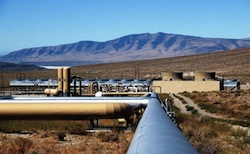Ormat Technologies, the U.S. Department of Energy and GeothermEx have successfully produced 1.7 additional megawatts from an Enhanced Geothermal System (EGS) project inside an existing wellfield in the U.S. –the first EGS project to be connected to the electricity grid. Using subsurface technologies, research and development teams stimulated an existing sub-commercial injection well resulting in a 38 percent increase in power output from brine at Ormat’s Desert Peak 2 geothermal power plant in the Brady complex, Churchill County, Nevada.
Support for the project included $5.4 million in direct DOE funding, $2.6 in million investment from Ormat, and more than four years of collaborative work with  partners including Lawrence Berkeley National Laboratory, U.S. Geological Survey, Sandia National Laboratory, University of Utah EGI, Temple University and TerraTek.
partners including Lawrence Berkeley National Laboratory, U.S. Geological Survey, Sandia National Laboratory, University of Utah EGI, Temple University and TerraTek.
Ormat explains that by expanding existing hydrothermal fractures deep within the Earth’s crust, EGS technology enhances the permeability of underperforming wells, making it possible to extract additional heat from a reservoir’s rocks and inject geothermal fluid at higher flow rates. Ormat’s air-cooled power plants don’t consume water in the conversion of energy into electricity; all the geothermal fluid is re-injected, to be produced again after heating in the reservoir.
“This research and development project was conducted under a stringent induced seismicity protocol developed by LBNL and the Department of Energy. We achieved an increased injection rate up to 1,600 gallons per minute without consuming or discharging water at the surface and using only existing geothermal brine returned to the original aquifer,” said Lucien Bronicki, founder and chief technology officer for Ormat. “Our objective in the Desert Peak EGS project was to demonstrate that this technology can have a significant impact on sub-commercial wells. This could enable us to use unproductive wells to generate more power and new revenue.”
“DOE’s Geothermal Technologies Office is changing geothermal development in the U.S.,” Bronicki added.

